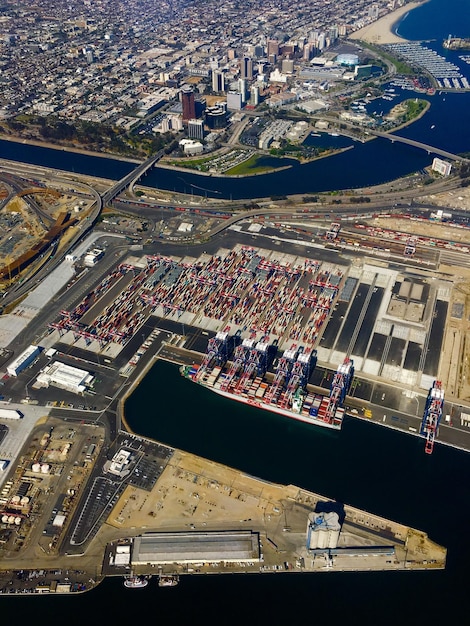Supply Chain Disruptions: Expert Strategies for US Businesses in the Next 6 Months

Supply Chain Disruptions: Expert Strategies for US Businesses to Mitigate Risks in the Next 6 Months involves diversifying suppliers, improving visibility, enhancing communication, building resilience through technology, and continuously assessing risks to ensure operational continuity during unforeseen events.
Navigating the complexities of today’s global market requires a keen understanding of potential disruptions to your supply chain. This article dives into Supply Chain Disruptions: Expert Strategies for US Businesses to Mitigate Risks in the Next 6 Months, offering actionable insights and proactive measures to safeguard your operations and maintain a competitive edge.
Understanding Supply Chain Vulnerabilities in the US Market
The US market, while robust, is not immune to supply chain shocks. Understanding the specific vulnerabilities that US businesses face is the first step in building a resilient supply chain. This section explores the key factors contributing to these vulnerabilities.
Geopolitical Risks
Geopolitical instability and trade tensions can significantly impact supply chains that rely on international sourcing. Tariffs, sanctions, and political conflicts can disrupt the flow of goods and increase costs.
Natural Disasters
The US is prone to various natural disasters, including hurricanes, earthquakes, and wildfires. These events can damage infrastructure, halt transportation, and disrupt production, causing significant delays and losses.

These factors can create unexpected challenges for US businesses. Consider these strategies:
- Diversify sourcing locations to reduce reliance on any single region.
- Develop contingency plans for key transportation routes and modes.
- Invest in real-time monitoring systems to track potential disruptions.
In conclusion, recognizing and understanding the specific vulnerabilities within the US market is crucial for businesses to proactively mitigate risks and build resilient supply chains. By addressing geopolitical risks and fortifying against natural disasters, companies can minimize disruptions and ensure operational continuity.
Diversifying Your Supplier Base for Enhanced Resilience
Relying on a single supplier can expose your business to significant risk. Diversifying your supplier base is a critical strategy to enhance resilience and mitigate the impact of disruptions. This section outlines how to effectively diversify your supplier network.
Identifying Critical Suppliers
Begin by identifying the suppliers that are most crucial to your operations. These are the suppliers that provide essential materials, components, or services that are difficult to replace.
Exploring Alternative Sourcing Options
Once you’ve identified your critical suppliers, explore alternative sourcing options. This may involve identifying domestic suppliers or exploring international suppliers in different regions.
Diversifying your suppliers requires careful planning and execution. Consider these steps:
- Conduct thorough due diligence on potential new suppliers.
- Establish clear communication channels with all suppliers.
- Negotiate flexible contracts that allow for adjustments in response to disruptions.

In conclusion, diversifying the supplier base is an essential strategy for enhancing supply chain resilience. By identifying critical suppliers, exploring alternative sourcing options, and building strong relationships with multiple providers, US businesses can mitigate the impact of disruptions and ensure a more stable and secure supply chain.
Improving Supply Chain Visibility with Technology
Real-time visibility into your supply chain is crucial for identifying and responding to disruptions quickly. Technology plays a vital role in enhancing visibility and enabling proactive risk management. This section explores the technological tools and strategies that US businesses can leverage.
Implementing Tracking and Tracing Systems
Tracking and tracing systems provide end-to-end visibility into the movement of goods throughout your supply chain. These systems use technologies like RFID, GPS, and IoT sensors to monitor the location and condition of products in real-time.
Leveraging Data Analytics and AI
Data analytics and artificial intelligence (AI) can help you analyze supply chain data to identify potential disruptions and predict future risks. These technologies can detect patterns, anomalies, and trends that might otherwise go unnoticed.
Implementing these technologies requires a strategic approach. Consider these best practices:
- Choose the right technology solutions to meet your specific needs.
- Integrate your technology systems to create a seamless flow of information.
- Train your staff to use the technology effectively.
In summary, improving supply chain visibility through technology is essential for effective risk management. By implementing tracking and tracing systems and leveraging data analytics and AI, US businesses can gain real-time insights into their supply chains, enabling them to anticipate and respond to disruptions more effectively.
Enhancing Communication and Collaboration with Stakeholders
Effective communication and collaboration with stakeholders are critical for mitigating the impact of supply chain disruptions. This section explores strategies to foster strong relationships with suppliers, customers, and other key partners.
Establishing Clear Communication Channels
Establish clear and reliable communication channels with all stakeholders. This includes regular updates, proactive alerts, and open lines of communication for addressing concerns.
Building Strong Relationships with Suppliers and Customers
Invest in building strong relationships with your suppliers and customers. This involves understanding their needs, addressing their concerns, and working together to find solutions to common challenges.
To improve communication and collaboration, consider these tactics:
- Hold regular meetings with key stakeholders to discuss potential risks and mitigation strategies.
- Use collaborative platforms to share information and coordinate responses.
- Develop a communication plan for managing disruptions and keeping stakeholders informed.
In conclusion, enhancing communication and collaboration with stakeholders is crucial for building a resilient supply chain. By establishing clear communication channels and fostering strong relationships with suppliers and customers, US businesses can improve coordination and mitigate the impact of disruptions.
Building Redundancy and Contingency Plans
Having redundancy and contingency plans in place is essential for minimizing the impact of supply chain disruptions. This section explores strategies to build resilience into your operations and prepare for unexpected events.
Developing Backup Plans for Critical Processes
Identify your critical processes and develop backup plans for each. This may involve having alternative suppliers, production facilities, or transportation routes in place.
Creating Inventory Buffers for Key Products
Maintain inventory buffers for key products to cushion against disruptions in supply. The size of the buffer will depend on the criticality of the product and the likelihood of disruptions.
Building redundancy and contingency plans requires a proactive approach. Consider these steps:
- Conduct regular risk assessments to identify potential disruptions.
- Develop detailed contingency plans for each identified risk.
- Test your plans regularly to ensure they are effective.
In summary, building redundancy and contingency plans is crucial for minimizing the impact of supply chain disruptions. By developing backup plans for critical processes and creating inventory buffers for key products, US businesses can build resilience into their operations and prepare for unexpected events.
Continuously Assessing and Adapting Your Strategy
The supply chain landscape is constantly evolving, so it’s essential to continuously assess and adapt your mitigation strategies. This involves monitoring emerging risks, evaluating the effectiveness of your plans, and making adjustments as needed.
Monitoring Emerging Risks and Trends
Stay informed about emerging risks and trends that could impact your supply chain. This includes geopolitical developments, economic conditions, technological advancements, and environmental factors.
Evaluating the Effectiveness of Your Mitigation Plans
Regularly evaluate the effectiveness of your mitigation plans. This involves tracking key performance indicators (KPIs) and assessing whether your plans are achieving their intended objectives.
To continuously improve your mitigation strategy, consider these steps:
- Establish a formal process for monitoring and evaluating your supply chain risks.
- Use data analytics to identify areas where your mitigation plans can be improved.
- Solicit feedback from stakeholders to identify blind spots and potential weaknesses.
| Key Point | Brief Description |
|---|---|
| 🌍 Diversify Suppliers | Reduce reliance on single sources; explore domestic and international options. |
| 📊 Improve Visibility | Use tracking, tracing, data analytics, and AI for real-time insights. |
| 🤝 Enhance Communication | Build strong relationships with suppliers and customers through clear channels. |
| 🛡️ Build Redundancy | Develop backup plans and maintain inventory buffers for critical products. |
FAQ Section
▼
Supply chain disruptions stem from various sources, including natural disasters, geopolitical instability, economic downturns, and unexpected events like pandemics. Each can halt production, delay shipments, and increase costs significantly.
▼
Diversifying your supplier base minimizes reliance on any single supplier. If one supplier faces issues, you can shift production to others, ensuring continuity and reducing the impact on your operations.
▼
Technologies like RFID, GPS, IoT sensors, data analytics, and AI enhance real-time tracking of goods. They also help in predicting potential disruptions by analyzing patterns and trends, enabling proactive responses.
▼
Clear and reliable communication is crucial for keeping all stakeholders informed. This includes suppliers, customers, and internal teams, ensuring coordinated responses and minimizing confusion during crises.
▼
Supply chain risks should be assessed continuously due to the ever-changing landscape. Regular monitoring, data analysis, and stakeholder feedback can help identify new risks and refine mitigation strategies proactively.
Conclusion
In conclusion, proactively addressing supply chain disruptions is essential for US businesses to thrive in an unpredictable global market. By implementing expert strategies like diversifying suppliers, leveraging technology for visibility, enhancing communication, building redundancy, and continuously assessing risks, companies can fortify their operations and maintain a competitive edge, ensuring resilience in the face of unforeseen challenges.





